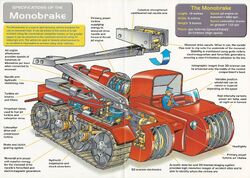
Monobrake cross-section
The Monobrake is a search and recovery vehicle used in tunnels where access to an accident is impossible to achieve using over vehicles. It allows International Rescue personnel to reach monotrain-related incidents by means of a cahelium-strengthened cantilevered elevating-telescopic-arm-mounted runner, adaptable to fit standard or narrow-gauge monorails. When in use, the monorail drive nacelle flips over to clip on to the underside of the monorail and the vehicle is lifted from the ground It is then propelled forward at speed by jet turbines. Stability is maintained using guide rollers and electro-magnetic forcefields, ensuring a near-frictionless adhesion to the monorail. This results in speeds up to 480kph, thanks to the turbojet engine. Its primary power turbine supplies energy to the monorail drive nacelle and forward thrust jet engine. The monorail arm power unit supplies energy for the monorail drive nacelle's force-field and electro-magnetic generators.
An acoustic detector and 3D thermal imaging system provides high resolution images of an accident site, and is able to identify where the victims are. The Monobrake is fitted with two fixed and two adjustable Zenohalogen searchlights, providing near-daylight-level illumination in sub-surface trackways. To be specific, the vehicle has standard operating searchlights (non-adjustable) and high-intensity variable power arc lamps (adjustable). The control compartment hood protects the operator(s) against excess heat from the power turbine and jet engine. Holographic images from the 3D scanner can be projected onto the inside of the hood.
